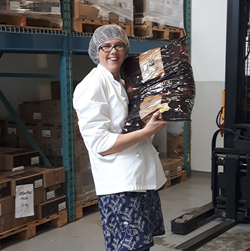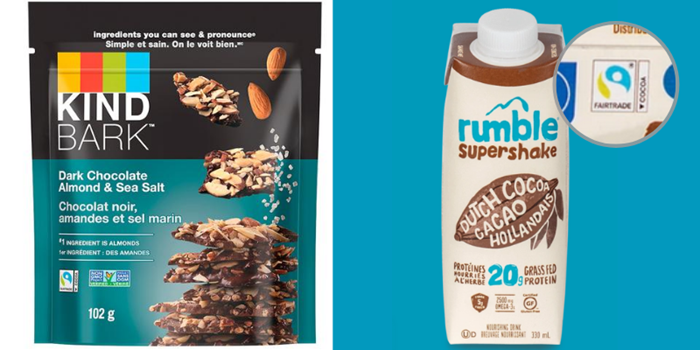Unpacking the Fairtrade Sourced Ingredient Model and What it Means for Fairtrade Cocoa
Helen is passionate about justice and equipping people to make a difference. She successfully pioneered and led a social justice charity equipping thousands of people to make a difference in their communities.

Now as Director of Business Development at Fairtrade Canada she encourages both brands and consumers to make a positive difference in the lives of farmers around the world. Helen works across a variety of categories and has a real love for chocolate and has been amazed and encouraged by the conversations she has had with Canadian brands and retail stores.
Connect with Helen on LinkedIn.
Fairtrade Canada (FC): To start, can you give us an overview of what is FSI and how it relates to cocoa?
Helen Reimer (HR): It’s probably a good idea to step back for a minute as well, and look at what our normal FAIRTRADE Product Mark actually means. When you see the FAIRTRADE Mark on a product, that indicates that all the ingredients in that product that can be Fairtrade are Fairtrade, which is pretty obvious when it comes to coffee or bananas.
But when it comes to more complex products, whether that’s a chocolate bar or a box of cereal, you start to see a lot more ingredients in there. If you see the FAIRTRADE Mark on these products, not only does that mean that all the ingredients that can be Fairtrade are Fairtrade, there’s also a rule that at least 20% of the ingredients in that product must be Fairtrade certified. That’s been established for a long time, and gives a lot of credibility around the product, because we know there is impact for producers.
But the challenge with that is it also restricts a lot of products from using the FAIRTRADE Mark at all, and can therefore disincentivize companies from actually sourcing those ingredients as Fairtrade. Take a lot of cereals, for example; they can have sugar in them but they might not have 20% sugar, so then they wouldn’t actually qualify to certify with Fairtrade. That was one of the reasons the Fairtrade Sourced Ingredient (FSI) model was trialed in Europe to see: would this increase the impact for producers?
FSI allows you to certify specific ingredients in your product. So if you see a product with the FAIRTRADE Mark that includes an adjacent arrow saying cocoa, you know that the cocoa in that product is Fairtrade certified. FSI was initially trialed in 2014 in Germany, and it was really incredible to see the results. Between 2009 and 2016, cocoa sales in Germany were averaging about 1,500 metric tons of cocoa, which is quite a lot of cocoa, and it was growing steadily. By 2016, it was 2,000 metric tons. But when they introduced the Fairtrade Sourced Ingredient label for cocoa in 2016, they actually sold a total of 30,000 metric tons. So you can see the real impact that had for producers because it meant they were selling more of their cocoa on Fairtrade terms, which also ensured they received the Fairtrade Minimum Price and the Fairtrade Premium.
FC: Fairtrade’s main focus has always been on increasing impact for producers and opening up more opportunities for producers to scale up their business. What does FSI mean for cocoa farmers and what kind of impact have we seen so far?
HR: By increasing sales from around 2,000 metric tons to 30,000 metric tons in Germany, you can see a big increase in impact there for the producers; it just opens up these doors. We’ve seen new companies here in Canada certifying ingredients recently as well. KIND Bark launched in North America with the Fairtrade cocoa FSI label. Rumble, a protein shake drink, which again wouldn’t have hit that 20% rule on their cocoa, now source Fairtrade cocoa.

Another benefit is that when a company chooses to use any FAIRTRADE Mark on their product, they also pay licensing fees for the use of the Mark. And that’s something consumers aren’t often aware of; I know I wasn’t before I joined the Fairtrade Canada team. Around 40% of those licensing fees go back into the international system to support producers. This includes training and supporting on-the-ground work of the Producer Networks. It also funds some incredible programs like the Women’s School of Leadership. Women’s empowerment is very important in Fairtrade, it’s one of our core pillars. But it’s not enough to just say, “Well, women should be empowered,” or, “You should have a certain number of women on your committee,” or, “Women should have equal rights.” I’ve heard so many interviews from women who said that before training from Fairtrade, they couldn’t look a man in the eye because they felt like they were a second-class citizen. They didn’t think that the community would respect them in the same way. The Women’s School of Leadership gives them practical tools, like how to actually run a business, how to understand financials and entrepreneurship.
The Women’s School of Leadership was partly funded by licencing fees generated under the Fairtrade Sourced Ingredient model. This program really demonstrates the impact that the FSI model is having.
FC: If Canadian businesses are looking to increase their commitment to sustainability, what can the FSI model provide for them?
HR: It is really important for companies who are already sourcing all of their ingredients as Fairtrade not to use this as a way to decrease their commitment to source sustainably. In practice, we haven’t seen that happen anywhere across the Fairtrade system. Companies who are buying all the ingredients as Fairtrade are committed to doing that, and committed to the impact it has. But what FSI is doing is opening up other avenues for companies and helping Fairtrade to open the door to new business partnerships where previously those doors may have been closed. And it’s allowing other companies who are already sourcing Fairtrade to explore expanding their sustainability commitment with other products or brands through FSI.
I can’t give too many details because these companies aren’t in the market yet, but I’ve had some really interesting conversations with a couple of significant and exciting companies here in Canada who will be launching soon. Probably due to COVID-19, it will be next year. And they were inspired to source cocoa with Fairtrade and label it because of this Fairtrade Sourced Ingredient model. Those products wouldn’t have qualified for the previous FAIRTRADE Product Mark because the percentages are too low. So this has been a real opportunity for them to start sourcing Fairtrade cocoa.
FC: We know that Canadians are increasingly looking for Fairtrade products, and chocolate is no exception (in 2019, we saw a 6% growth in cocoa sales). What does the Fairtrade chocolate market look like in Canada at the moment, and how have brands responded to the FSI model?
HR: I’ve always had a soft spot for chocolate, partly because I love it, it’s a great product. But also one of the first companies I visited and one of the first companies I signed up to become a Fairtrade licensee when I joined Fairtrade Canada was Whistler Chocolates. And it was great working with them as a brand in that transition period and, more recently, to see their growth.
Earlier this year, I visited Theobroma chocolate in Quebec City, and also had several meetings with Galerie au Chocolat. And of course, there’s other great products like Camino, PRANA, Just Us! Chocolates and Nature’s Path as well. They may not be a chocolate bar, but Nature’s Path source Fairtrade cocoa for their Love Crunch brand. And to those companies, they’re all really excited by the growth that they are seeing in Fairtrade, the increased demand they’re having for their products. Retailers are also choosing to have their own label chocolate with the Fairtrade Mark on it – you see Fairtrade certified chocolate bars in Federated Coop in Calgary, Sobeys in Ontario and Quebec and Fairtrade certified cocoa nibs in Loblaws. And it’s great to see this area growing, and that’s driven by demand, as well by consumers because if consumers are demanding it, companies will do it.